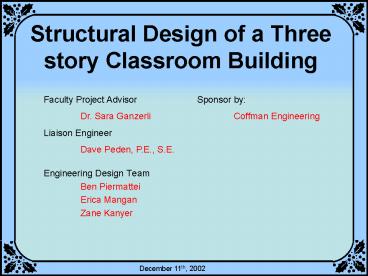Structural Design of a Three story Classroom Building PowerPoint PPT Presentation
1 / 17
Title: Structural Design of a Three story Classroom Building
1
Structural Design of a Three story Classroom
Building
Faculty Project Advisor Dr. Sara
Ganzerli Liaison Engineer Dave Peden, P.E., S.E.
Sponsor by Coffman Engineering
- Engineering Design Team
- Ben Piermattei
- Erica Mangan
- Zane Kanyer
December 11th, 2002
2
Project Introduction
- Structural design of a three-story classroom for
Whitworth College. - 33,000 Square feet and 50 feet tall
- Architectural features include sloped roofs,
auditoriums, large classroom and conference rooms
and foyer. - Steel Construction with architectural brick and
concrete foundation.
3
Design Process
- Completed Tasks
- Schematic Phase
- Initial placements of column and beams
- Initial loads including wind and earthquake
- Tasks in Progress
- Design Development Phase
- Lateral system
- Initial beam and column sizing
- Tasks to be completed
- Construction Documents Phase
- Problems Encountered
- Roof Design
- Auditorium
- Transfer Beams
4
Dead and Live Loads
- The unfactored live load is 70 pounds per square
foot as stated in Uniform Building Code (UBC)
1997 for office buildings with a partitions. - The unfactored dead load was calculated to be 56
pounds per square foot. This includes - Structural Elements
- Concrete slab on metal deck
- Open web joists (14K4 _at_ 3.25)
- Steel Beams and Columns (Assume W14x193)
- Architectural, Mechanical, Electrical Elements
- Veneer
- Insulation
- Non-structural walls
- Total dead load is 56 pounds per square foot
- Snow Load is 30 pounds per square foot and roof
dead load is 30 pounds per square foot.
5
Earthquake Base Shear
- Mass of the building at each floor was calculated
and the UBC 97 was used to find earthquake loads.
- Given the following information
- seismic zone 2b
- Sd Soil type
- Importance factor of 1.0
- Assume Ordinary steel moment frame
- Total Base Shear in either directions is 419 Kips.
6
Lateral System
- Types of Lateral Systems
- Bracing
- Shear Walls
- Moment Frame
7
Bracing
- Advantages
- Minimal Deflections
- Less Material
- Cost Effective
- Disadvantages
- No open areas in walls (i.e. windows)
8
Shear Wall
- Advantages
- Minimal Deflections
- Usually around elevators and stairs
- Disadvantages
- Loose strength if holes need to be cut in it.
- Usually around elevators and stairs
9
Moment Frame
- Advantages
- Allows for windows in walls, and other open
spaces
- Disadvantages
- Large deflections
- Larger Members
- Cost increase
10
Selection
- After considering many possibilities, a moment
frame was chosen as our lateral system.
11
Problems Encountered
- Roof Design
- Sloped Roof
- Truss Design
- Supports
- Auditorium
- Two Story Overhang
- Beam Sizes
- Roof Design
- Transfer Beams
12
Wind Base Shear Calculations
- The wind base shear is calculated using the 1997
UBC equation 20-1 (PCeCqqsIw) - P Wind Pressure
- Ce Combined Height, Exposure, and Gust
Coefficient - Cq Pressure Coefficient
- qs Wind Stagnation Pressure
- Iw Importance Factor
- Coefficients are obtained based on the fact that
the structure is a classroom building with an
occupancy of more than 500 - located on a college campus in Spokane, WA
13
Construction Document Phase
- Members will be designed based on the following
- Applicable Loading
- Ease of Placement
- Standard Sizes Available
- Cost Analysis
- All members and typical connections will be shown
in detailed AutoCAD drawings - All documents will be compiled and organized.
14
Column Placement
- Column placement was based on the following
- Location of architectural gridlines
- Placement that allows for continual columns
through all three floors - Ability to easily place beams and joists between
columns
15
Beam Placement
- In most cases beams span from column to column in
order to transfer the gravity loads down to the
foundation - Beams placed in the moment frames transfer axial
loads to the lateral resisting system - Beams placed along the wall of the building pick
up load from the exterior elements such as
architectural features and some interior loads
16
Transfer Beams
- Due to the following cases the design team has
decided to use transfer beams to transfer the
load from one beam to two columns - The building is not symmetrical
- Several architectural features make it impossible
to connect every beam to a column
17
Conclusion
- The placement of beams and columns was completed
rather quickly. Gravity loads and lateral loads
were also relatively simple to calculate using
local guidelines along with the 1997 UBC. - The lateral system has been chosen as a moment
frame. - Roof design and the auditorium have posed some
problems. The roof will most likely be
supported by trusses. The load above the
auditorium will either be supported by cantilever
or by spanning two large beams over the
auditorium. - Both the schematic and design development phases
are nearly complete and the group expects to
begin the design document phase soon.

